Post by TasunkaWitko on Nov 30, 2012 16:32:10 GMT -5
Holubky (Stuffed Cabbage Rolls)
My wife's grandmother emigrated to the US from Slovakia in the early part of the 20th century, and brought this traditional recipe with her. The beautiful Mrs. Tas grew up making these with her, and it is always a comforting, special event for her when we make these at home. I have a full step-by-step pictorial on how our family makes these, and you can see it by clicking here:
foodsoftheworld.activeboards.net/holbky-starej-mamy-plnen-kapusta_topic149.html
We recently made these again, and they simply never get old ~ here are a few photos and notes.
This time around, I wanted to "bring the dish home" a little bit, and try to put a few twists in that would hopefully be something more like they were made in "the old country." With that goal in mind, I made a couple of substitutions and additions to the time-honoured recipe that my wife's grandmother would use, and also added paprika to the meat mixture, since the region where the family is from was part of the Hungarian Empire until very recently, and paprika was a much-used spice there.
The first change I made was to add chopped mushrooms to the mix; one of the memories I remember the Beautiful Mrs. Tas speaking of is how her grandmother would go "mushroom hunting" in the area, searching up into the draws and hollows where they lived. It seemed to me that chopped mushrooms would be a natural ingredient here, especially considering that most peasant households in central and eastern Europe were very "meat poor."
I also decided to employ kasha as a filler and binder for the meat mixture, rather than the customary rice. Both grains are and were common there, but kasha is the one that I see most in reference to "the old recipes." To prepare the kasha for the dish, I soaked it in hot water for around 15 minutes to soften it up, and used the resulting "kasha water" as part of the braising liquids when simmering the holubky.
With these changes, I decided to call this dish holúbky s hubami a kaše, which is simply "holubky with mushrooms and kasha."
Here we are, with some ingredients for this experimental preparation:

Left to right, behind the mushrooms: chopped onion, kasha soaking in hot water (note the red colour, which is evidently characteristic) and canned, whole tomatoes from the garden.
Preparation was fairly easy, as always; the first thing I did was to briefly saute the onions and mushrooms, in order to get a little flavour into the dish, and remove any "raw" tastes from the final product:
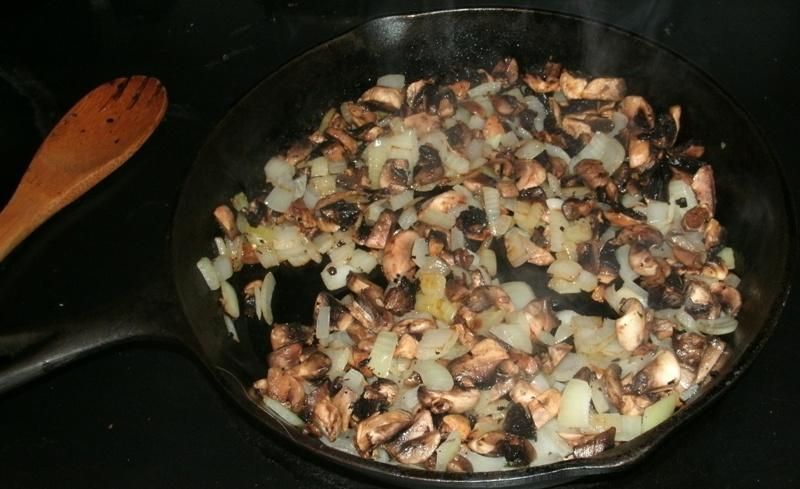
When the onions began to caramelise, I also added some finely-diced garlic:
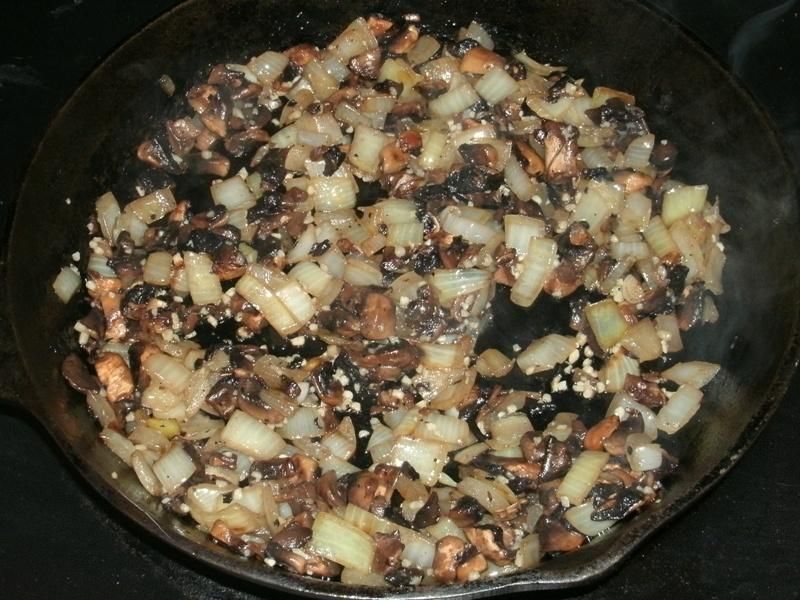
After letting the garlic heat up a bit and sweat out some flavour, but before it began to turn brown, I removed the pan from the heat and gave the mixture a healthy dose of paprika, maybe 2 tablepoons. I then stirred the paprika into the mixture as the residual heat begain to melt it and darken the spice, releasing a wonderful aroma:
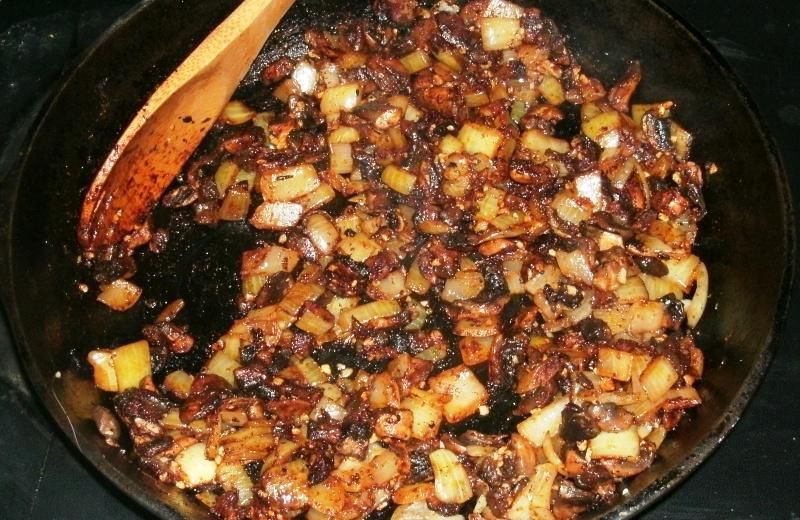
Then, the pan went immediately to the freezer to sit on a couple of dishtowels and cool off, so that the hot onions and mushrooms would not begin cooking the meat when they were added to the filling.
At about this same time, I dropped a head of cabbage into a pot of water and brought it to a simmer in order to parboil the leaves and loosen them so that they could be removed and stuffed as demonstrated in the opening post:

We find that it helps to core the cabbage:
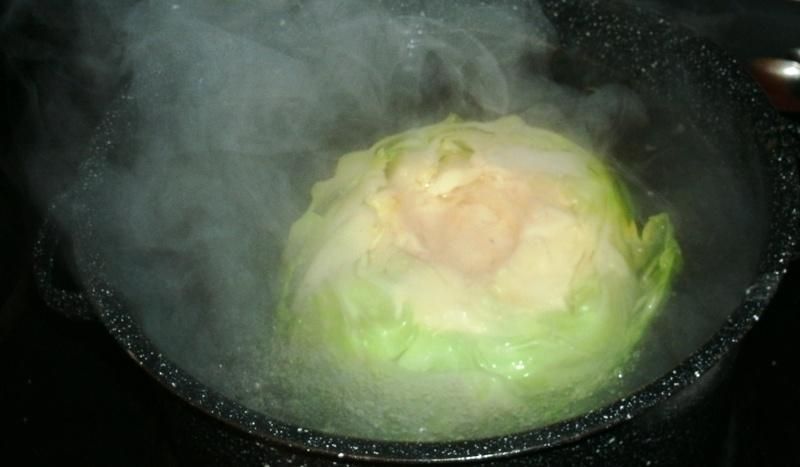
But that is not a strictly-necessary step.
By the time the leaves were stripped, the onion and mushroom mixture had cooled enough to assemble the meat filling. Nothing complicated here, just toss the contents of the pan onto the meat:

And then mix everything together thoroughly:
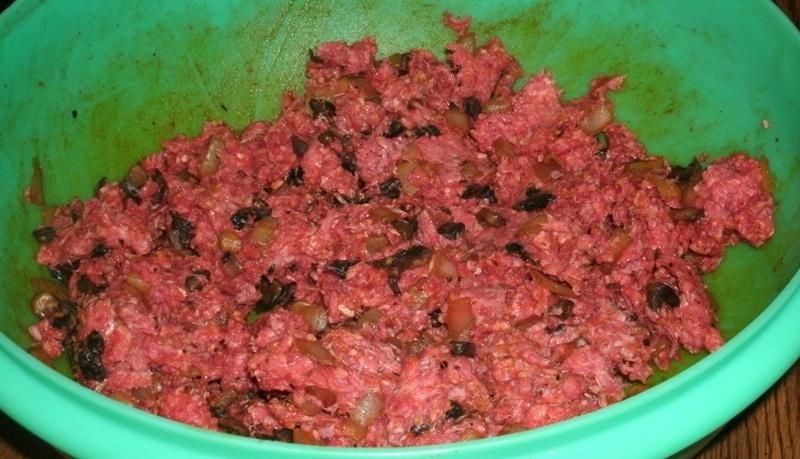
I applied gentle application of a hand-held potato masher, and achieved good results using this method.
After seasoning to taste with a little marjoram, salt and pepper, I thoroughly incorporated the kasha into the filling:
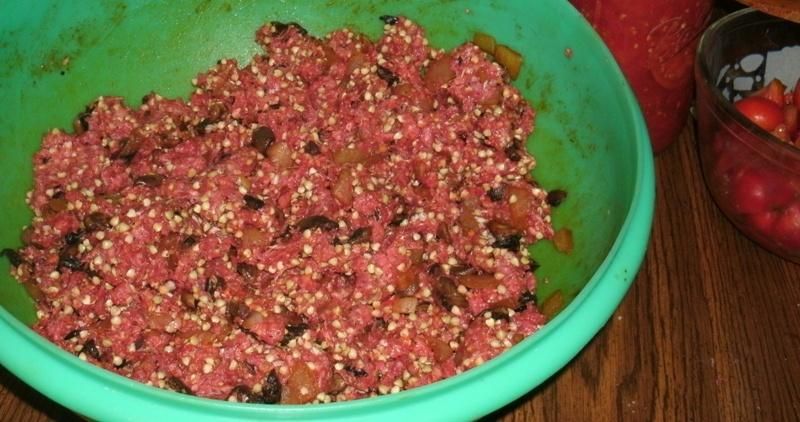
I then proceeded to make the holubky as outlined in the opening post, layering them in my enameled cast iron Dutch oven. In between each layer of cabbage rolls, I put a layer of sauerkraut, tomatoes and chopped-up "ends and pieces" of cabbage leaves. When I ran out of filling and cabbage leaves, I covered the casserole and put into the oven at 350 degrees, using the kasha water and juice from the canned tomatoes as a braising liquid.
I had planned on getting a couple of plated pictures, as well as a photo or two of the holubky cut open, but when supper was ready, everyone around me dug in and made a huge mess of things, so I decided "maybe next time."
Results were great! I enjoyed this method very, very much. The kasha softened up to perfection as it simmered in the casserole, adding a unique flavour and velvety texture to the filling. The mushrooms and paprika also fit in very well with the dish, and the end result was special indeed. The Beautiful Mrs. Tas was horrified at what I did to her "pigs in a blanket," and seemed to think that the alterations I amde turned them into a whole other dish entirely; but even she had to admit, they tasted great ~ they just weren't HER GRANDMA'S pigs....
Normally we have some leftovers for lunch the next day, and that was the case this time as well. Throughout the weekend, we had them for lunch and, like many similar dishes, they got even better as time passed.
With that, I declare my experiment a success, and would enthusiastically recommend that you consider giving it a try.
My wife's grandmother emigrated to the US from Slovakia in the early part of the 20th century, and brought this traditional recipe with her. The beautiful Mrs. Tas grew up making these with her, and it is always a comforting, special event for her when we make these at home. I have a full step-by-step pictorial on how our family makes these, and you can see it by clicking here:
foodsoftheworld.activeboards.net/holbky-starej-mamy-plnen-kapusta_topic149.html
We recently made these again, and they simply never get old ~ here are a few photos and notes.
This time around, I wanted to "bring the dish home" a little bit, and try to put a few twists in that would hopefully be something more like they were made in "the old country." With that goal in mind, I made a couple of substitutions and additions to the time-honoured recipe that my wife's grandmother would use, and also added paprika to the meat mixture, since the region where the family is from was part of the Hungarian Empire until very recently, and paprika was a much-used spice there.
The first change I made was to add chopped mushrooms to the mix; one of the memories I remember the Beautiful Mrs. Tas speaking of is how her grandmother would go "mushroom hunting" in the area, searching up into the draws and hollows where they lived. It seemed to me that chopped mushrooms would be a natural ingredient here, especially considering that most peasant households in central and eastern Europe were very "meat poor."
I also decided to employ kasha as a filler and binder for the meat mixture, rather than the customary rice. Both grains are and were common there, but kasha is the one that I see most in reference to "the old recipes." To prepare the kasha for the dish, I soaked it in hot water for around 15 minutes to soften it up, and used the resulting "kasha water" as part of the braising liquids when simmering the holubky.
With these changes, I decided to call this dish holúbky s hubami a kaše, which is simply "holubky with mushrooms and kasha."
Here we are, with some ingredients for this experimental preparation:

Left to right, behind the mushrooms: chopped onion, kasha soaking in hot water (note the red colour, which is evidently characteristic) and canned, whole tomatoes from the garden.
Preparation was fairly easy, as always; the first thing I did was to briefly saute the onions and mushrooms, in order to get a little flavour into the dish, and remove any "raw" tastes from the final product:

When the onions began to caramelise, I also added some finely-diced garlic:

After letting the garlic heat up a bit and sweat out some flavour, but before it began to turn brown, I removed the pan from the heat and gave the mixture a healthy dose of paprika, maybe 2 tablepoons. I then stirred the paprika into the mixture as the residual heat begain to melt it and darken the spice, releasing a wonderful aroma:

Then, the pan went immediately to the freezer to sit on a couple of dishtowels and cool off, so that the hot onions and mushrooms would not begin cooking the meat when they were added to the filling.
At about this same time, I dropped a head of cabbage into a pot of water and brought it to a simmer in order to parboil the leaves and loosen them so that they could be removed and stuffed as demonstrated in the opening post:

We find that it helps to core the cabbage:

But that is not a strictly-necessary step.
By the time the leaves were stripped, the onion and mushroom mixture had cooled enough to assemble the meat filling. Nothing complicated here, just toss the contents of the pan onto the meat:

And then mix everything together thoroughly:

I applied gentle application of a hand-held potato masher, and achieved good results using this method.
After seasoning to taste with a little marjoram, salt and pepper, I thoroughly incorporated the kasha into the filling:

I then proceeded to make the holubky as outlined in the opening post, layering them in my enameled cast iron Dutch oven. In between each layer of cabbage rolls, I put a layer of sauerkraut, tomatoes and chopped-up "ends and pieces" of cabbage leaves. When I ran out of filling and cabbage leaves, I covered the casserole and put into the oven at 350 degrees, using the kasha water and juice from the canned tomatoes as a braising liquid.
I had planned on getting a couple of plated pictures, as well as a photo or two of the holubky cut open, but when supper was ready, everyone around me dug in and made a huge mess of things, so I decided "maybe next time."
Results were great! I enjoyed this method very, very much. The kasha softened up to perfection as it simmered in the casserole, adding a unique flavour and velvety texture to the filling. The mushrooms and paprika also fit in very well with the dish, and the end result was special indeed. The Beautiful Mrs. Tas was horrified at what I did to her "pigs in a blanket," and seemed to think that the alterations I amde turned them into a whole other dish entirely; but even she had to admit, they tasted great ~ they just weren't HER GRANDMA'S pigs....
Normally we have some leftovers for lunch the next day, and that was the case this time as well. Throughout the weekend, we had them for lunch and, like many similar dishes, they got even better as time passed.
With that, I declare my experiment a success, and would enthusiastically recommend that you consider giving it a try.





